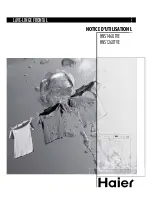
en
Utensils
12
2.
Carefully pour rinse aid up
to the max. mark in the filler opening.
3.
Close cover until it clicks shut.
4.
To prevent excessive foam formation
during the next rinse cycle, remove
any rinse aid which has run over with
a cloth.
Setting amount of rinse aid
The amount of rinse aid dispensed can
be set in 4 stages. Accordingly 0, 1, 2
or 3 displays are lit (see water hardness
table).
Factory setting: 2.
Do not change the amount of rinse aid
unless streaks (select lower
setting) or water stains (select higher
setting) are left on the utensils.
1.
Close the door.
2.
Switch on ON/OFF switch
(
.
The Cleaning display
)"
flashes.
3.
Press and hold down the START
button
8
.
4.
Rotate programme selector
0
until
the rinse aid refill indicator
P
flashes.
5.
Release button.
The rinse aid refill indicator
P
flashes and the displays
h
and
`
are lit (= Setting 2).
To change the setting:
1.
Rotate programme selector
0
until
the required setting has been
selected.
2.
Press START button
8
.
The rinse-aid refill indicator
P
goes
out. The selected setting is saved.
Switching off rinse-aid refill
indicator
If the rinse-aid refill indicator
P
is
impaired (e.g. when using combined
detergents containing rinse-aid
component), it can be switched off.
ヽ
Proceed as described under “Setting
amount of rinse aid” and select
setting 0.
The rinse aid refill indicator
P
is now
switched off.
-
Utensils
U
t
e
n
s
i
l
s
Not suitable
ヽ
Cutlery and utensils made of wood.
ヽ
Delicate decorative glasses, craft
and antique utensils. These decors
are not dishwasher-proof.
ヽ
Plastic parts not resistant to heat.
ヽ
Copper and tin utensils.
ヽ
Utensils which are soiled with ash,
wax, lubricating grease or ink.
Aluminium and silver parts have a
tendency to discolour and fade during
the wash cycle. Even some types of
glass (e.g. crystal glass objects) may
turn cloudy after many wash cycles.
PD[













































